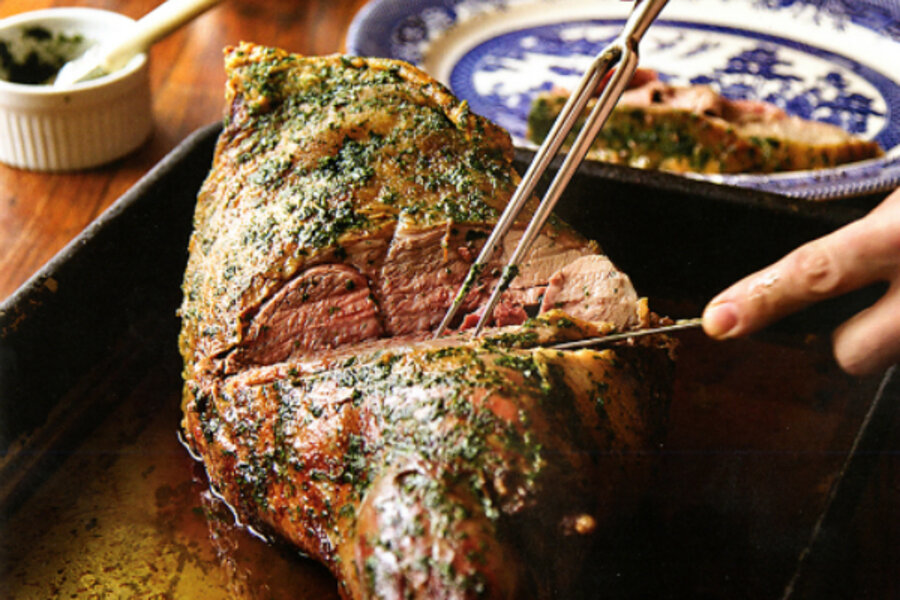The true spirit of St. Patrick's Day
Loading...
As residents of Boston, we get a big dose of Irish every March 17. This is a city, after all, where Celtic pride even extends to our basketball team. The Irish pubs specialize in green beverages, live music, and lots of rowdy college kids. In added drama this year, the traditional St. Patrick's Day in South Boston parade has taken a decidedly political turn.
There's always a lot going on in Boston as the town gets painted green and pent-up energy gets released – maybe too much – in part to satisfy the yearning for warmer weather and the first spring leaves.
So I was intrigued when I came across a passage in My Irish Table, a new cookbook by chef Cathal Armstrong, describing how St. Patrick's Day is actually celebrated in Ireland. Hint: The rivers remain their natural color.
Armstrong is a celebrated chef in the Washington, D.C., area, a pioneer in growing his own fresh produce used in his restaurants, and has even played host to President and Michelle Obama as they celebrated their 19th wedding anniversary at his Restaurant Eve.
"My Irish Table," co-written with food writer David Hagedorn, is full of traditional emerald gems such as "Shepherd's Pie" and "Irish Soda Bread," along with dishes that reflect Armstrong's developed sophistication in the kitchen, such as this "Roast of Leg au Jus with Herb Pesto."
If you feel like doing a duck-and-cover and staying home after the parade to avoid the shamrock-wearing crowds on St. Patrick's Day, congratulate yourself on a bit of Irish authenticity. Because in Ireland that's what most families will be doing, too.
Excerpt from "My Irish Table," by Cathal Armstrong and David Hagedorn:
"At home, Saint Patrick's Day is a religious holiday that celebrates Patrick bringing Christianity to Ireland in the fifth century. It is observed with the same kind of reverence that Americans have for Thanksgiving, but more solemn. There's a big parade in Dublin that everybody goes to – just like the Macy's Thanksgiving Day Parade – but every little village has its own parade as well.
"On Saint Patrick's Day, we don't drink green beer, we don't dye the rivers green, and we don't get really drunk. It is actually a stay-at-home day on which many pubs are closed.
"Saint Patrick's Day usually falls in the middle of Lent when everybody is fasting or abstaining, but on this one day we are given a special dispensation from the Church and are allowed to break the fast and have a celebration. After everybody goes to Mass, the family gather for an elegant spring meal that typically features Roast Leg of Lamb, Roast Prime Rib of Beef, or even Baked Whole Salmon. One thing you probably won't find on the Irish table is Corned Beef, which is an American tradition."
Roast Leg of Lamb au Jus with Herb Pesto
From "My Irish Table" by Cathal Armstrong, reprinted with permission (Ten Speed Press)
Serves 8 to 10
1 (9-pound) bone-in leg of lamb, H-bone removed by your butcher
2 tablespoons extra-virgin olive oil
2 teaspoons kosher salt
1 cup lamb demi-glace [demi-glace is stock slowly reduced by half over low heat, strained, and cooled]
Herb pesto
1/2 cup extra-virgin olive oil
6 cloves garlic, crushed
1 cup fresh basil leaves
2 tablespoons chopped fresh thyme leaves
2 tablespoons chopped fresh rosemary leaves
1/2 teaspoon kosher salt
Roast the lamb: Preheat the oven to 350 degrees F. Place the leg fat side up in a flameproof roasting pan. Rub it with the oil and season with the salt. Roast for 1-1/2 hours, until a meat thermometer inserted into thickest part of lamb (but not touching the bone) registers 135 degrees F. for medium rare.
Make the pesto: Meanwhile, place the oil and garlic in the bowl of a food processor or blender and pulse briefly. Add the basil and process until a coarse purée forms. Add the thyme, rosemary, and salt and process briefly, until incorporated.
Add the pesto to the lamb: Transfer the lamb leg to a cutting board and spread 4 tablespoons of herb pesto over it. Cover the leg loosely with aluminum foil and let it rest for 15 minutes.
Make the jus: Meanwhile, skim and discard the fat from the roasting pan. Add the demi-glace to the pan and place over medium-high heat. Use a flat-edged wooden spatula to scrape up all the brown bits from the bottom of the pan.
Present the dish: Pour the jus into a smaller pitcher or gravy boat. Spoon the remaining pesto into a small serving bowl. Transfer the lamb to a serving platter and carve it at table. At about the middle of the leg, use a carving knife to cut a horizontal wedge the width of the leg and about 2 inches wide, cutting at a 45 degree angle from both sides until you've hit the bone. Then cut thin slices from both sides of the wedge. Once you've carved as much meat that way as you can, grasp the bone and stand it on its end with one hand, using your other hand to cut slices off the leg. Spoon some jus over each serving and place a little pesto on the side. Serve with your chosen side dishes.






